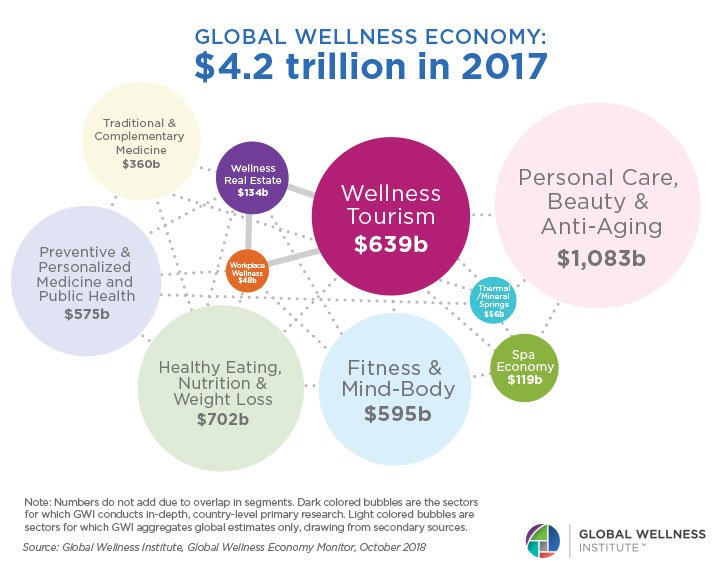Wellness Is Growing Faster Than the Global Economy. Here’s Why
Yes, the pun is intended, but the numbers don't lie. The wellness industry was valued at $4.2 trillion in 2017, clocking 12.8% growth from 2015. Let’s put this in perspective: Wellness is growing roughly twice as fast as the global economy–which means spending on wellness is now more than half as large as total global health expenditures ($7.3 trillion)!
The infographic below gives a comprehensive overview of industries that encourage people to incorporate wellness activities and lifestyles into their daily lives. Each of the 10 bubbles represents a wellness sector, which is sized in proportion to how much it contributes to the annual global wellness economy.

Curious to know more? The following descriptions capture what is included in each of the bubbles, moving from the smallest wellness market to the largest.
- Workplace wellness: To attract and retain superstar employees, an increasing number of companies are spending more on health and wellness programs, services, activities and equipment. It's a$48 billion market, growing 4.8% a year.
- Thermal/mineral springs: Is there something magic in the water? Yes, to the tune of $56 billion. The recreational and therapeutic uses of water with special properties—including thermal water, mineral water, and seawater—are becoming more popular. Think of the Blue Lagoon in Iceland or the ocean-fed pool at Gurney's in the Hamptons.
- Spa economy: Treat yourself. This sector, already valued at $118 billion, is growing nearly 10% per year.
- Wellness real estate: As wellness becomes more integrated into our day-to-day life, more homes and commercial/institutional properties are bringing wellness elements into their design. Examples include everything from intentionally health-focused housing communities to hotels with meditation rooms. It's a $134 billion market, expanding 6.4% a year.
- Traditional and complementary medicine: This sector encompasses diverse medical, healthcare, holistic and mentally or spiritually based systems, services and products. These include homeopathic, naturopathic, chiropractic, Traditional Chinese Medicine, Ayurveda, energy healing, traditional/herbal remedies and supplements, etc. It all adds up to $360 billion.
- Preventive and personalized medicine and public health: This $575 billion sector includes medical services that focus on treating “well” people, preventing disease, or detecting risk factors; and personalized health approaches for individual patients.
- Fitness and mind-body: This $595 billion sector includes everything from boutique meditation studios to leggings to fitness trackers—everything in your workout life, basically.
- Wellness tourism: It's pretty self-explanatory: all travel associated with the pursuit of maintaining or enhancing one’s personal wellbeing. All of those yoga retreats and healthy cruises add up to a $639 billion industry, growing 6.5% yearly.
- Healthy eating, nutrition, and weight loss: This $702 billion segment includes everything from organic food to protein shakes to weight-loss programs. That's a lot of Clif bars.
- Personal care, beauty, and anti-aging: This goliath $1.1 trillion market looks pretty much unstoppable. It includes beauty and salon services, dermatology, cosmetics, and everything else involved in making people look and feel their best. What's more, it's expanding 4.1% yearly, making it a true growth industry.
So, the next time you think about wellness—and what makes up a truly holistic approach—I hope you return to this visual. It will make your understanding of the components of a well life solid and defensible… not fuzzy or vague.

{{post.sponsorText}}
Susie Ellis is the chairwoman and CEO of the Global Wellness Institute. She is also chairman and CEO of the Global Wellness Summit. Recognized as one of the leading authorities on the multi-sector wellness industry, she is frequently cited in major global publications.
What should Susie write about next? Send your questions and suggestions to experts@www.wellandgood.com.
Loading More Posts...